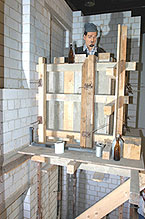Schrift: größer/kleiner
Inhaltsverzeichnis
Sie sind hier: WirRheinländer > english version > Federal Republic of Germany and the Economic Miracle (1949 – early 1950s) > Reconstruction
Federal Republic of Germany and the Economic Miracle
Reconstruction
After 1945 Rhenish cities assumed the heritage of Berlin as the capital of Germany and Prussia, the commercial centre of the old empire. In 1946 the British made Düsseldorf the seat of government in North Rhine-Westphalia in what was formerly Prussia. In 1949 Bonn became capital city of West Germany. The German Chamber of Commerce and Industry, the German Trades Union Congress and other associations moved to the Rhine. For the economy of the Rhineland, the distance to influential politicians and lobbyists was shortened by almost 600 kilometres.
Companies continued to move away from Berlin, after the Soviet blockade of 1948/49 had exposed the frail position of the western part.

Despite the war and confiscations, the Rhineland still retained a large potential labour force and structurally productive major industries. The growing East-West conflict supported the understanding among Western powers that the reconstruction of their zones, or even of western Europe, could not succeed without an economic recovery at the Rhine and Ruhr. Instead of continually weakening the west German infrastructure by removing parts of the remaining machinery of production, the Marshall-Plan of the USA helped the Germans to achieve strategic financial stimulation and new creditworthiness.
With half on loan and repayment scheduled for the middle of 1952, American help for West Germany had the effect of an economic and psychological kick-start. The main recipient was North Rhine-Westphalia, where the money flowed principally into coal mining, communications and transport, as well as energy and public utilities.
By 1951 industrial production in West Germany had exceeded that of 1938. At the end of the decade it had more than doubled.
| Year | Industrial production (1950 =100) |
Employed(Mio.) | Unemploy-ment among dependent employees (%) | Cost of Living Index(1950 =100) |
Gross hourly earnings (1950 =100) |
|---|---|---|---|---|---|
|
1949 |
80 |
13,5 |
8,3 |
107 |
95 |
| 1950 |
100 |
13,8 |
10,3 |
100 |
100 |
| 1951 |
118 |
14,6 |
9,0 |
108 |
115 |
| 1952 |
126 |
15,0 |
8,4 |
110 |
124 |
| 1953 |
139 |
15,6 |
7,5 |
108 |
130 |
| 1954 |
155 |
16,3 |
7,0 |
108 |
133 |
| 1955 |
178 |
17,2 |
5,2 |
110 |
142 |
| 1956 |
192 |
18,1 |
4,1 |
113 |
156 |
| 1957 |
203 |
18,6 |
3,4 |
115 |
170 |
| 1058 |
209 |
18,8 |
3,5 |
119 |
182 |
| 1959 |
225 |
19,4 |
2,4 |
121 |
191 |
From 1950 till 1960 Gross Domestic Product tripled. In 1952, for the first time an export surplus was achieved.
The Marshall-Plan, the deutschmark and a market economy breathed new life into Germany in an astoundingly short time. For example, average earnings increased in real terms by 50 percent during the 1950's. The labour expenditure for basic consumer articles fell by 30, for luxury goods, alcohol and tobacco by 50 or 60 percent.
| Month and Year | 1 Kg Sugar | 1 Kg Butter | 1 Kg Coffee | 1 VW Beetle |
|---|---|---|---|---|
| November 1949 | 58 min. | 4 hrs. 23 min. |
22 hrs. 37 min. |
3.946 hrs. |
| November 1958 | 32 min. | 2 Std. 58 min. |
8 hrs. 2 min. |
1.675 hrs. |
| October 1970 | 11 min. | 1 Std. 11 min. |
2 hrs. 41 min. |
787 hrs. |
| October 1975 | 10 min. | 52 min. | 1 hrs. 37 min. |
690 hrs. |
| July 1983 | 9 min. | 42 min. | 1 hrs. 36 min. |
607 hrs. |
However, working hours remained at roughly 48 in a six-day week. The deutschmark made many goods more expensive and had lost a fifth of its purchasing power by 1959.
On the introduction of the deutschmark in June 1948, the population started with a "reward" of 40 DM per capita. Companies received an interim payment of DM 60 per employee for business purposes. Initially, the new banknotes looked foreign. The appearance of 20-DM-notes even resembled American dollar bills. In addition there were 1/2-DM-notes, because of the continuing shortage of metal for coins.
The hope that currency reform would distribute wealth more justly among the people was a deceit: in 1960 almost three quarters of private wealth belonged to one sixth of all households.


